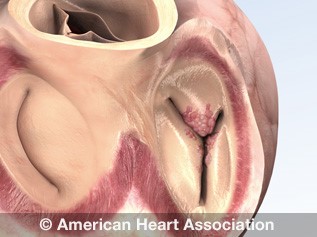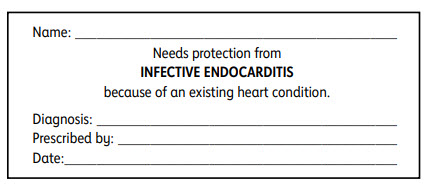Infective Endocarditis
Infective endocarditis (IE) is when there is inflammation of the inner lining of the heart or heart valves. This is often caused by bacteria, which can be called bacterial endocarditis. IE is uncommon, but people with some conditions have a greater risk of developing it.
Risk factors for developing IE include:
- Heart valve conditions
- Weakened immune system
- Artificial heart valve, pacemaker or defibrillator
- Intravenous (IV) drug use
- Previous heart valve surgery
- Congenital heart disease
- Heart damage from rheumatic fever
- Poor dental health
- Other causes

View an illustration of endocarditis.
Dental procedures and infective endocarditis
Adults with the highest risk for poor outcomes from IE may be prescribed antibiotics (IE prophylaxis) before certain dental procedures to reduce their risk of developing it. These include procedures that involve manipulation of gingival (gum) tissue or the periapical region (area around the roots) of teeth, or perforation of the oral mucosa.
Antibiotic prophylaxis is reasonable before the above-mentioned dental procedures for people with heart conditions who have any of the following:
- Prosthetic heart valve or prosthetic material used for heart valve repair
- Previous IE
- Certain congenital heart diseases (CHD) ‒ Your cardiologist will let you know if your CHD requires use of antibiotics.
- Heart transplant recipients who develop heart valve disease
Antibiotic prophylaxis may be reasonable for certain medical procedures on the respiratory tract or infected skin, skin structures or musculoskeletal tissue for adults with underlying heart conditions associated with the highest risk of poor outcomes from IE.
Antibiotic prophylaxis is not recommended solely to prevent IE for adults who have some non-dental procedures, including genitourinary or gastrointestinal tract procedures. You can help reduce the risk of IE by maintaining good oral health through regular professional dental care and the use of dental products such as manual, powered and ultrasonic toothbrushes; dental floss; and other plaque-removal devices.
If you meet the requirements for antibiotic prophylaxis for dental treatment or oral surgery, your cardiologist or other health care professional may give you an American Heart Association wallet card (PDF). Show this card to your dentist, pediatrician, family physician or other health care professional. It recommends the type of antibiotic and dose for IE prophylaxis. For smaller children, the dose will vary according to the child's weight. Always remind your dentist or physician if you (or your child) are allergic to any antibiotics or other medications.
Your health care team can provide you with more information and answer your questions about preventing IE.
- Print our patient information sheet What Is Endocarditis? (PDF) | Spanish (PDF)
- Print your own Prevention of Infective Endocarditis Wallet Card (PDF) | Spanish (PDF)
Support that lifts you up

Our online community of patients, survivors and caregivers is here to keep you going no matter the obstacles. We’ve been there, and we won’t let you do it alone.

